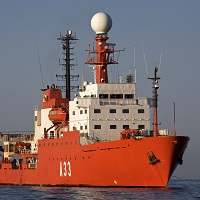Keyword
North Atlantic Ocean
197 record(s)
Type of resources
Categories
Topics
INSPIRE themes
Keywords
Contact for the resource
Provided by
Years
Formats
Status
-

Transit Cartagena-Las Palmas-Salvador de Bahía
-

Acoustic seabed characterization by inversion techniques and evaluation of immersive echogram.
-

Echo-sounding and noise inherent in the BIO Hesperides
-

Annual Progress Monitoring and quantification of the uptake of CO2 in the Atlantic
-

Latitudinal patterns in regulation of the oceanic plankton production
-
Transit.
-
This equipment trials cruise has provided opportunities for test and verification of technology under development at the Proudman Oceanographic Laboratory (POL), the Scottish Association for Marine Science (SAMS) and the National Oceanography Centre, Southampton (NOC,S). This includes equipment developed during the first year of funding under OCEANS 2025 (theme 8). Testing technology in the ocean environment is invaluable in assessing fitness for purpose. Specifically, the cruise tested: A Spar wave buoy (NOC,S) biogeochemical sensors (NOC,S); an UAV system (NOC,S); a video grab system "HyBis" (NOC,S), A benthic Multicore (NOC,S), A benthic lander and associated torroidal Telemetry buoy (POL), and a shallow tow towfish (POL). Testing in Spanish waters (near Tenerife, Gran Canaria and Fuerteventura) has been invaluable. The time on passage has been minimised (the transition from deep to shallow water is less than a days steaming) and the calm conditions to the southwest of the islands in the consistent prevailing north easterly winds have enabled deployment and recovery techniques to be tried and optimised in safety.
-
The objective of cruise DY039 was to service the moorings of the RAPID 26°N project that are deployed to monitor the Atlantic Meridional Overturning Circulation. For each mooring instruments were recovered, data were downloaded and instruments were redeployed. A number of CTDs were made to calibrate the instruments from the moorings. In addition to the standard instruments used in previous years on the RAPID array, biogeochemical instruments were deployed for the ABC Fluxes project, along with some additional temperature sensors and ADCPs for the MerMeed project. During passage from Southampton to Tenerife trial CTDs were completed in international waters. After a short port call in Santa Cruz de Tenerife, departing on the 26th October work commenced on the eastern boundary sub-array comprising of moorings EBH4, EBH4L, EBH3, EBH2, EBH1, EBH1L, EBHi, EB1 and EB1L. A lander was deployed alongside EBHi to provide delayed-mode data telemetry through timed data pod release. Work on the MAR sub-array commenced on 7th November at mooring MAR3. The other moorings in this sub-array (MAR3L, MAR1, MAR1L, MAR2 and MAR0) were all completed by 12th November. The NOG mooring was also recovered and redeployed as part of the MAR sub-array servicing. Mooring WB6 was serviced on 19th November before transiting to Nassau for customs clearance. The remaining western boundary sub-array moorings (WBADCP, WBAL, WB1, WB2, WB2L, WBH2, WB4 and WB4L) were serviced between the 22nd November and the 30th November before docking in Nassau on the 1st December.
-
SHOM cruise between Brest and Lisbon
-
Transit.
 Catálogo de datos del IEO
Catálogo de datos del IEO